Chapter: Biochemistry: Photosynthesis
Cyclic Electron Transport in Photosystem I
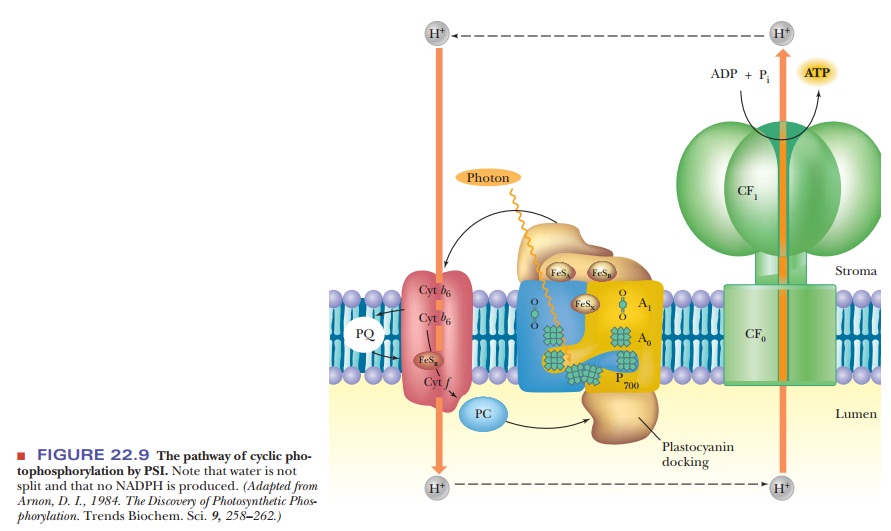
Cyclic Electron Transport in
Photosystem I
In addition to the electron transfer reactions just described, it is possible for cyclic electron transport in photosystem I to be coupled to the production of ATP (Figure 22.9). No NADPH is produced in this process. Photosystem II is not involved, and no O2 is generated. Cyclic phosphorylation takes place when there is a high NADPH/NADP+ ratio in the cell: not enough NADP+ is present in the cell to accept all the electrons generated by the excitation of P700.
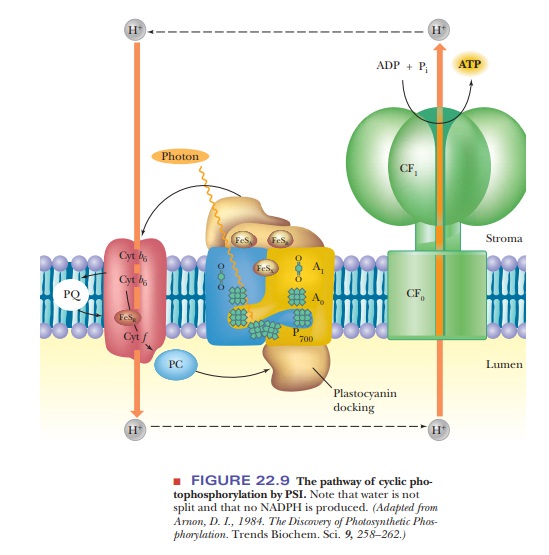
What is known about the structure of photosynthetic reaction centers?
The molecular structure of photosystems is a subject of intense
interest to biochemists. The most extensively studied system is that from
anaerobic phototropic bacteria of the genus Rhodopseudomonas.
These bacteria do not produce molecular oxygen as a result of their
photosynthetic activities, but enough similarities exist between the
photosynthetic reactions of Rhodopseudomonas
and photosynthesis linked to oxygen to lead scientists todraw conclusions
about the nature of reaction centers in all organisms. Since the structure of
this photosystem was elucidated by X-ray crystallography, the structures of PSI
and PSII have also been determined and have been shown to be markedly similar.
Consequently, the detailed process that goes on at the reaction center of Rhodopseudomonas is important enough to
warrant further discussion.
It is well established that there is a pair of bacteriochlorophyll
molecules (designated P870 from the fact that light of
870 nm is the maximum excitation wavelength) in the reaction center of Rhodopseudomonas viridis; the critical
pair of chlorophylls is embedded in a protein complex that is in turn an
integral part of the photosynthetic membrane. (We shall refer to the
bacteriochloro-phylls simply as chlorophylls in the interest of simplifying the
discussion.)
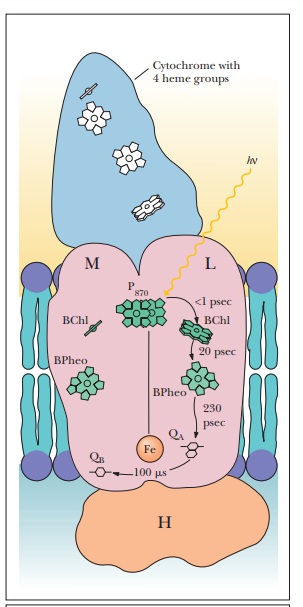
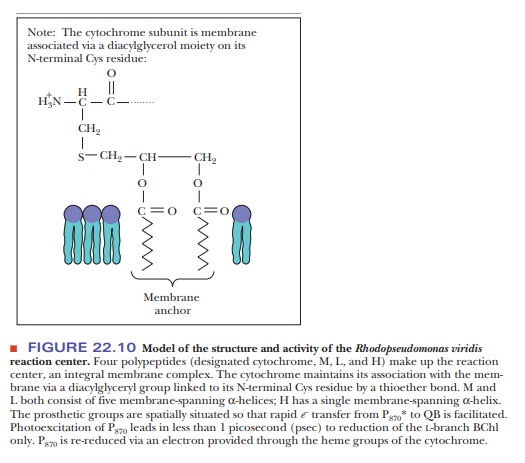
Accessory pigments, which also play a role in the light-trapping
process, have specific positions close to the special pair of chlorophylls. The
absorption of light by the special pair of chlorophylls raises one of their
electrons to a higher energy level (Figure 22.10). This electron is passed to a
series of accessory pig-ments. The first of these accessory pigments is
pheophytin, which is structurally similar to chlorophyll, differing only in having
two hydrogens in place of the magnesium. The electron is passed along to the
pheophytin, raising it in turn to an excited energy level. (Note that the
electron travels on only one of two possible paths, to one pheophytin but not
the other. Research is in progress to determine why this is so.) The next
electron acceptor is menaquinone (QA); it is structurally similar to coenzyme
Q, which plays a role in the mitochondrial electron transport chain (Figure
22.11). The final electron acceptor, which is also raised to an excited state,
is coenzyme Q itself (ubiquinone, called QB here). The electron that had been
passed to QB is replaced by an electron donated by a cytochrome, which acquires
a positive charge in the process. The cytochrome is not bound to the membrane
and diffuses away, carrying its positive charge with it. The whole process
takes place in less than 10-3 s. The positive and negative
charges have traveled in opposite directions from the chlorophyll pair and are
separated from each other. This situation is similar to the proton gradient in
mitochondria, where the existence of the proton gradi-ent is ultimately
responsible for oxidative phosphorylation.
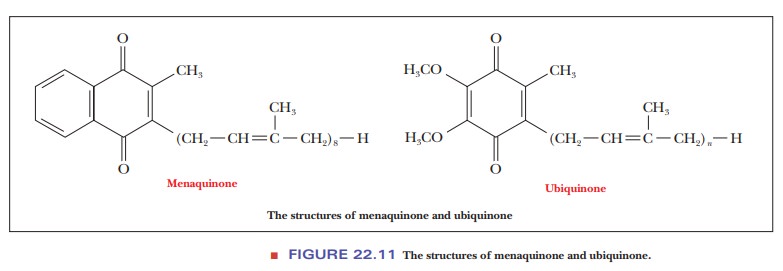
The separation of charge is equivalent to a battery, a form of
stored energy. The reaction center has acted as a transducer, converting light
energy to a form usable by the cell to carry out the energy-requiring reactions
of photosynthesis. The processes that take place in Rhodopseudomonas serve as a model for reaction centers in
photosynthesis linked to oxygen.
Summary
Photosynthesis
consists of two processes. The light reactions are elec-tron transfer
processes, in which water is oxidized to produce oxygen and NADP+ is
reduced to produce NADPH. The dark reactions are also electron transfer
processes, but here carbon dioxide is reduced to carbohydrates.
The path
of electrons in the light reactions of photosynthesis can be con-sidered to
have three parts. The first is the transfer of electrons from water to the
reaction-center chlorophyll of photosystem II.
The
second part is the transfer of electrons from the excited-state chlo-rophyll of
photosystem II to an electron transport chain consisting of accessory pigments
and cytochromes, with energy provided by absorption of a photon of light. The
components of this electron transport chain resemble those of the mitochondrial
electron transport chain; they pass the electrons to the reaction-center
chlorophyll of photosystem I.
The
third and last part of the path of the electrons is their transfer from the
excited-state chlorophyll of photosystem I to the ultimate electron acceptor
NADP+, producing NADPH; again, energy is provided by absorp-tion of
a photon of light.
Related Topics